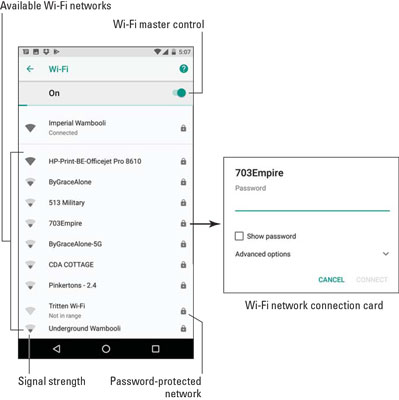Connecting to a Wi-Fi network
After you activate the Wi-Fi function on your Android phone or tablet, it automatically connects to any known Wi-Fi network ― meaning one that you’ve accessed before and for which the password is still valid. If not, you can hunt down an available network. Follow these steps:- Visit the Wi-Fi screen in the Settings app.
- Select a wireless network from the list. Available Wi-Fi networks appear on the screen, similar to what’s shown in the figure. When no wireless networks are listed, you're out of luck regarding wireless access from your current location.
- If prompted, type the network password.
Tap the Show Password check box so that you can see what you’re typing; some of those network passwords can be long.
- Tap the CONNECT button. The network is connected immediately. If not, try the password again.
- If prompted to remember the network, do so. Some Androids may ask whether you want to automatically reconnect to the same Wi-Fi network in the future. Choose that option.
 Hunting down a wireless network
Hunting down a wireless network
While your Android is connected to a wireless network, the Wi-Fi Connected status icon, which looks like a tiny fan, appears at the top of the touchscreen (see the figure above). This icon indicates that the Wi-Fi function is on and the device is connected and communicating with a Wi-Fi network.
- Some public networks require that you sign in to their web pages after connecting. The sign-in page may appear automatically. If not, open the web browser app and visit any page to be redirected to the sign-in page. Heed the directions there to gain network access.
-
A wireless network without a password is considered unsecure. The absence of security makes it easier for people to do bad things on the network. My advice is to use the connection but avoid sending sensitive information over a nonsecured public network.
- The Wi-Fi connection works best when you plan on being in a specific location for an extended time. That’s because the Wi-Fi signal goes only so far. If you wander too far away, the signal — and your connection — are lost.
- The Wi-Fi connection stays active until you wander out of range. To deliberately disconnect from a Wi-Fi network, turn off the device’s Wi-Fi function.
Connecting to a WPS router
Many Wi-Fi routers feature a Wi-Fi Protected Setup (WPS). It’s a network authorization system that’s simple and secure. If the wireless router features WPS, follow these steps to quickly connect your phone or tablet to the network:- Visit the Wi-Fi screen in the Settings app.

- Tap the WPS connection button on the router. The button either is labeled WPS or uses the WPS icon, shown here.
- On your Android, choose Wi-Fi Preferences. This item is found at the bottom of the list of available networks on the Wi-Fi screen. If not, tap Action Overflow and choose Advanced.
- Choose WPS Push Button or WPS Pin Entry, depending on how the router does its WPS thing. If you don’t see these items, expand the Advanced category. For a WPS push-button router, push the WPS button on the router. For a WPS PIN router, look on the device’s touchscreen for a PIN. Type that number on the Wi-Fi router.






